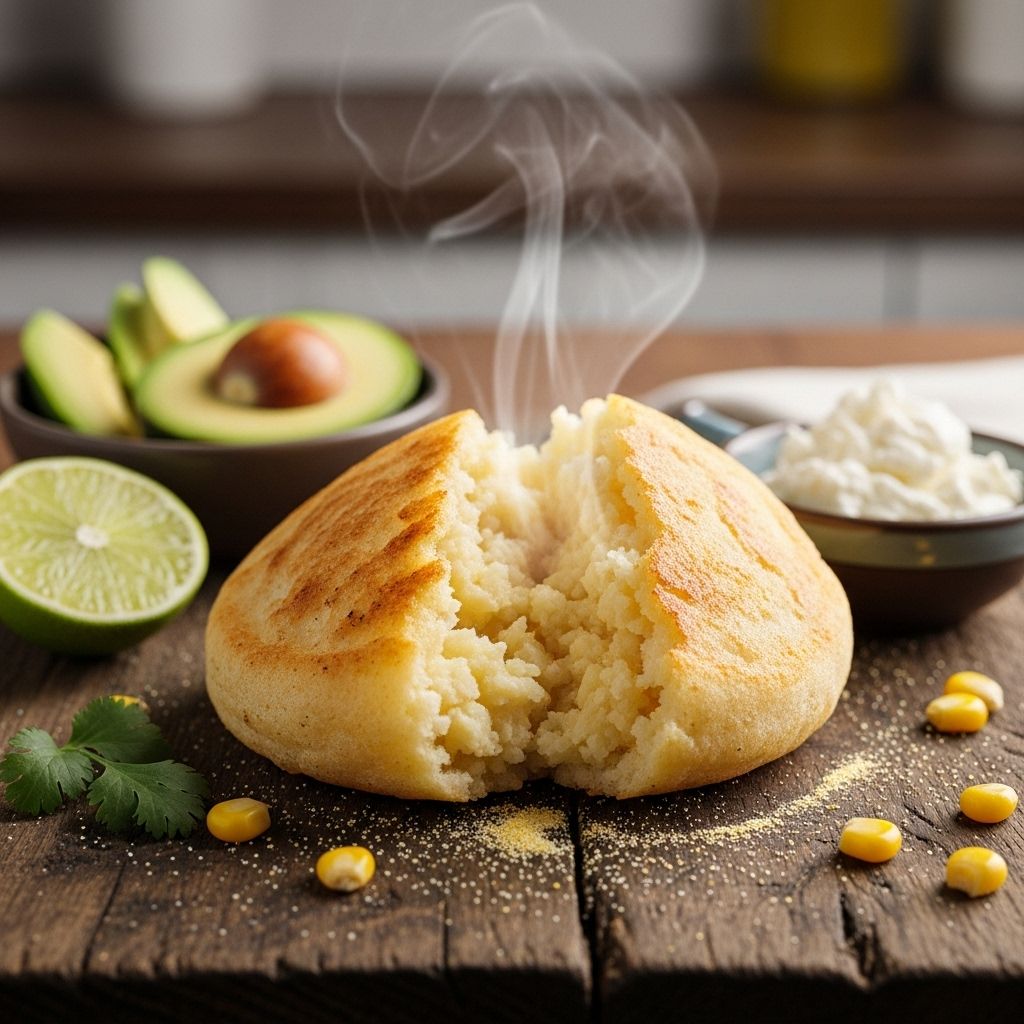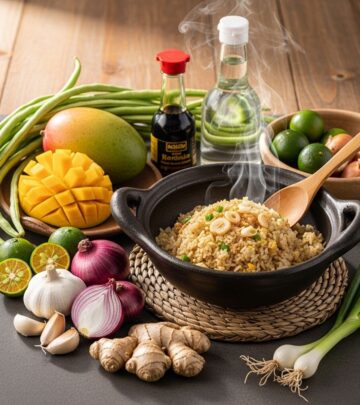Homemade Arepas Recipe: 6 Steps To Crispy, Fluffy Corn Cakes
Discover how to make authentic arepas from scratch with step-by-step instructions, tips, and delicious serving ideas.

Image: HearthJunction Design Team
Homemade Arepas: The Ultimate Guide to Classic Latin Corn Cakes
Arepas are thick, savory cornmeal cakes beloved throughout Latin America, particularly in Venezuela and Colombia. With a crispy crust and tender, fluffy interior, homemade arepas are as versatile as they are delicious. They can be enjoyed plain, filled with cheese, or stuffed with a variety of tasty fillings, making them a household staple and an irresistible comfort food. In this comprehensive guide, you’ll discover everything you need to know to make perfect arepas from scratch, including the ingredients list, step-by-step instructions, pro tips, nutritional insights, and creative serving ideas.
Ingredients for Classic Homemade Arepas
- 2 1/2 cups lukewarm water
- 1 teaspoon salt
- 2 cups pre-cooked white cornmeal (such as P.A.N.®)
- 1/4 cup vegetable oil, or as needed, for frying
Note: Pre-cooked white cornmeal, also called masarepa or harina precocida (P.A.N. is a popular brand), is essential. Traditional cornmeal or masa harina will not yield the right texture.
Step-by-Step Instructions
- Make the Dough
In a medium bowl, combine 2 1/2 cups lukewarm water and 1 teaspoon salt. Gradually add 2 cups of pre-cooked white cornmeal, stirring with your fingers. As you mix, the dough will start forming and become malleable and soft but not sticky. Let it sit for a few minutes to hydrate fully.
- Shape the Arepas
Divide the dough into 8 equal pieces. Roll each piece into a smooth ball, then flatten gently with your palms to form patties about 2 inches in diameter and roughly 3/8 inch thick. Smooth the edges for even cooking and a classic look.
Want to indulge in a cheesy delight? Don’t miss our guide to cheese-stuffed Colombian-style arepas, where rich, melted cheese meets the classic arepa for a truly satisfying experience. They are sure to impress your family and friends! - Cook the Arepas
Heat 1/4 cup vegetable oil in a large skillet over medium heat. Working in batches, place the arepas in the skillet. Fry for about 4 to 5 minutes per side, or until they develop a golden-brown, crispy crust. Adjust heat as needed to prevent burning, and add more oil if the pan gets dry between batches.
- Drain and Cool
Once golden and crisp, transfer cooked arepas to a plate lined with paper towels. Let them cool slightly—just enough to handle.
Next, elevate your meal experience by trying our Colombian arepas de huevo recipe, where a perfect fried egg is nestled inside a golden arepa. This recipe blends simplicity with the rich flavors of Latin cuisine for a breakfast treat that's hard to resist. - Slice and Fill
Using a thin, serrated knife, carefully slice each arepa horizontally to form a pocket, similar to a pita. Be careful not to slice all the way through; the goal is to create a pocket for stuffing.
- Serve and Enjoy
Serve warm as is, or fill with your favorite toppings and fillings. See serving ideas below for inspiration.
Looking for a scrumptious side dish to complement your arepas? Explore our delicious potato and corn empanadas with aji sauce recipe. These savory bites add a satisfying crunch and zest to your meal.
Expert Tips for Perfect Arepas
- Use Only Pre-Cooked Cornmeal: Harina precocida (such as P.A.N.®) is essential for the authentic texture. Do not substitute with regular cornmeal or masa harina.
- Hydrate the Dough Fully: Allow the dough to rest for a few minutes after mixing to ensure that the cornmeal fully absorbs the water, making shaping easier.
- Consistency is Key: The dough should be moist and malleable but not sticky. If it’s too dry or cracks as you form the patties, add a bit more water, a tablespoon at a time. If it’s sticky, add a little more cornmeal.
- Don’t Crowd the Pan: Fry arepas in batches so each one cooks evenly and can be flipped easily.
- Check Doneness: Arepas should sound slightly hollow when tapped and have a crisp, golden crust with a tender interior.
Serving Suggestions and Filling Ideas
Arepas are famously versatile and can be enjoyed in many ways. Here are some popular serving ideas and classic fillings:
- Cheese: Stuff the pocket with your favorite cheese while the arepa is still warm so it melts inside.
- Ham and Cheese: Layer slices of ham and cheese for a quick and satisfying sandwich.
- Shredded Chicken or Beef: Fill with pollo mechado (shredded chicken) or carne mechada (shredded beef) with a touch of sauce.
- Egg and Avocado: Fill with scrambled eggs, sliced avocado, and a pinch of salt for a breakfast arepa.
- Black Beans and Plantains: For a vegetarian option, stuff arepas with seasoned black beans, sweet plantains, and fresh cheese.
- Butter: For a simple treat, split an arepa and spread with butter while hot.
Nutrition Information
| Nutrient | Per Serving (1 Arepa) | Notes |
|---|---|---|
| Calories | Approx. 190 | Based on oil retention value of 10% |
| Fat | 7g | Primarily from frying oil |
| Carbohydrates | 28g | From cornmeal |
| Protein | 3g | |
| Sodium | 300mg | Varies with salt and fillings |
Note: The exact nutritional values will vary depending on the specific oil used, how much is absorbed, additional fillings, and serving size. The above figures are estimates based on standard preparation.
Storage and Make-Ahead Tips
- Arepas are best enjoyed fresh and warm, but leftovers can be cooled, wrapped tightly, and refrigerated for up to 3 days.
- To reheat, split and toast in a dry skillet or oven until warmed through and crisp again.
- The dough can be made a few hours in advance, but shape and cook just before serving for the best texture.
Common Arepas Variations
- Arepas de Queso: Mix grated mozzarella or other melty cheese into the dough for richer, cheesier arepas.
- Colombian Arepas: Typically thinner and sometimes filled with cheese or butter inside before cooking.
- Arepitas Dulces: Sweeten the dough slightly with a bit of sugar and serve with honey or condensed milk.
Troubleshooting & Frequently Asked Questions
Q: My arepas are cracking or falling apart. What went wrong?
A: The dough was likely too dry. Try adding a tablespoon or two of water and kneading gently until the dough is supple and moist but not sticky.
Q: Can I bake arepas instead of frying?
A: Yes, baked arepas are a lighter alternative. Place formed arepas on a parchment-lined baking sheet and bake at 375°F (190°C) for about 20–25 minutes, flipping halfway through. They won’t be as crispy as fried but are still delicious.
Q: What fillings are traditional?
A: In Venezuela, popular fillings include cheese, ham, shredded chicken, or beef, black beans, or even eggs and avocado. The Colombian style sometimes includes cheese melted inside the arepa.
Q: What if I can’t find P.A.N. or harina precocida?
A: For authentic results, seek out pre-cooked white or yellow cornmeal marketed specifically for arepas. Latin or international markets usually carry it, and some grocery stores have it in the Latin foods aisle.
Q: Can I freeze cooked or uncooked arepas?
A: Yes. Cooked arepas can be cooled, wrapped, and frozen for up to 2 months. Thaw and reheat in the oven or toaster. Uncooked dough doesn’t freeze well, but you can freeze shaped, raw arepas and cook them from frozen—just increase frying or baking time slightly.
Arepas Around Latin America
Arepas have deep roots in Latin American culinary tradition, most notably in Venezuela and Colombia, where each country offers its own spin on the recipe and fillings. In Venezuela, arepas are often thicker and used to make sandwiches known as areperas, while Colombian arepas tend to be thinner and may have cheese melted inside. No matter where you try them, arepas always serve as a canvas for creative, hearty, and soul-satisfying meals.
Conclusion: Bringing Authentic Latin Flavors to Your Kitchen
Homemade arepas are a celebration of simple, wholesome ingredients—cornmeal, water, salt, and oil—transformed into a comforting staple found on breakfast, lunch, and dinner tables across Latin America. With just a few steps and plenty of space for creativity, you can master the art of arepa-making at home. Whether served as a snack, main dish, or side, filled with meats, cheese, or veggies, arepas promise crispy exteriors, tender interiors, and pure culinary satisfaction with every bite. Enjoy experimenting with fillings, flavors, and traditions, and share this classic comfort food with family and friends!
Frequently Asked Questions (FAQs)
Q: Are arepas gluten-free?
A: Yes, as long as you use 100% corn-based pre-cooked cornmeal (harina precocida), arepas are naturally gluten-free.
Q: Can I make mini arepas for parties?
A: Absolutely! Just make smaller balls of dough and flatten into petite rounds before cooking. Mini arepas are perfect for appetizers or party snacks.
Q: What’s the best oil for frying arepas?
A: Any neutral vegetable oil with a high smoke point, such as canola, sunflower, or corn oil, works well for frying arepas.
References
Read full bio of Anjali Sayee












